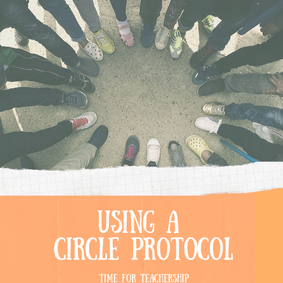|
My last post talked about the value of choosing a few protocols for consistent use. Circles are my favorite protocol of all time. They democratize the classroom. Students are often more engaged than usual, and members of the class have the opportunity to learn about each other and build relationships. It’s good stuff. What is a circle protocol? Rooted in indigenous traditions and ways of being (Living Justice Press), circles are used to build community and resolve conflict peacefully. I was taught circle practice includes 5 main components: an opening ceremony, a closing ceremony, a talking piece, a centerpiece, and participants seated in a circle (with no desks or furniture in the middle). While you will want to co-create norms for your circle practice with your students, there are a few basic norms all circles need to have. First, all participants in the circle sit. This includes the teacher. Second, no one speaks without the talking piece. Again, this includes the teacher (unless there is a serious issue that needs to be addressed). Third, when a question is asked, the talking piece is passed around so every participant touches the talking piece and thus has an opportunity to answer. How do I plan for a circle? When preparing to introduce circle practice for the first time, I put up a list of the 5 components of a circle and explain them to students. Also, consider how you want to co-construct the norms for circles. (These norms will be your norms for the remainder of the year. You may revisit them or refine them as needed, but it’s important to try to do this well.) I use the circle protocol to have each student share one norm to start. Finally, you’ll want to think about your first circle topic. For a first circle, it’s nice to choose a topic that helps participants learn about each other. You also want to choose a topic that everyone can easily talk about. I often use “Story of My Name,” in which all participants share their name and a story about it (e.g., how they got their name, what it means for them, if people mispronounce it). Once you’ve had the first circle, planning for future circles is focused more on the core questions you will pose to students. I typically backwards plan circles from the purpose. I think about what I want students to get out of the circle. Then, I consider the main question I want them to discuss. From there, I pick a few scaffolding questions if I think they need it (we may need to define common terms or concepts and get on the same page so that everyone can access and respond to the deeper, focus question). Then, I choose an opening and a closing. Sometimes, I’ll re-use the same opening in multiple circles (e.g., “In one word, share how you’re feeling right now”) or the same closing (I used “Clap once in unison—without counting down”). Often, I will share a relevant quote for the opening and/or closing. You can also plan a more involved activity or protocol within a circle (like inner circle/outer circle share), but most of the time, I keep it simple. How do I facilitate a circle? There are a few tips I try to keep in mind while facilitating. Most importantly, the facilitator is a model for how the talking piece works. Don’t talk without it unless absolutely necessary. If side conversations happen, I try to redirect students with my eyes and then address the problem when the talking piece gets back to me. As a facilitator, it’s good to wear a watch or have another way to keep track of time. A full go-around for one question takes longer than you might think. When you’re short on time and unsure if you’ll be able to complete one more round/question, you can add a time restriction to your question or prompt. (I usually use, “Answer this next question in one sentence.”) I want to learn more. What resources are available to me? There is a lot to think about when you first start using the circle protocol, so I made you a free circle-specific lesson planning template. I initially created this for students when I asked them to plan and run their own circles, which was a big success. So, you can use this template for yourself and for students once you get to the point where students are familiar enough with the circle protocol to take the lead! This book has premade circle lessons that are phenomenal. It contains relevant sections including, but not limited to: getting started with circles, co-creating norms for circle practice, discussing issues of equity, circles for staff and parents, and restorative discipline and conflict resolution circles. Morningside Center is the organization that trained me. Members of this organization wrote the suggested book above. Their site routinely publishes current events circles on topics that emerge in the news. These are excellent resources to address students’ SEL needs and discuss how students are experiencing (or not experiencing) values in their lives in school, outside of school, or when reading/watching the news.
0 Comments
Leave a Reply. |
Details
For transcripts of episodes (and the option to search for terms in transcripts), click here!
Time for Teachership is now a proud member of the...AuthorLindsay Lyons (she/her) is an educational justice coach who works with teachers and school leaders to inspire educational innovation for racial and gender justice, design curricula grounded in student voice, and build capacity for shared leadership. Lindsay taught in NYC public schools, holds a PhD in Leadership and Change, and is the founder of the educational blog and podcast, Time for Teachership. Archives
May 2024
Categories |





 RSS Feed
RSS Feed